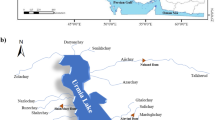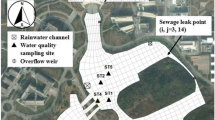Abstract
This study designs a multipurpose urban shallow artificial lake, including water supply, flood detention, and water environment preservation. It is expected to not only preserve a healthy water environment but to also retain water conservation and flood detention. This study adopts system dynamics (SD) to analyze the relationship between different purposes of water resources utilization. Furthermore, different operation strategies effects can be simulated by SD through a proposed urban multipurpose shallow artificial lake system. The results demonstrate the dynamic effects of strategies managers propose such as demand analysis, inflow control, and water quality improvement in this case study for Taiwan. SD aids lake system prediction and understanding temporally in sequential planning for water supply, environmental preservation, and flood detention. The SD model will hopefully serve as a reference to study different features before artificial lakes constructing.









Similar content being viewed by others
References
Ahmad, S., & Simonovic, S. P. (2000). System dynamics modeling of reservoir operations for flood management. Journal of Computing in Civil Engineering, 14(3), 190–198. doi:10.1061/(ASCE)0887-3801(2000)14:3(190).
Basha, H. A. (1995). Routing equations for detention reservoirs. Journal of Hydraulic Engineering, 121(12), 855–887. doi:10.1061/(ASCE)0733-9429(1995)121:12(885).
Chow, V. T., Maidment, D. R., & Mays, L. W. (1988). Applied hydrology. New York: McGraw-Hill.
Filippelli, G. M. (2008). The global phosphorus cycle: Past, present, and future. Elements, 4(2), 89–95. doi:10.2113/GSELEMENTS.4.2.89.
Güneralp, B., & Barlas, Y. (2003). Dynamic modelling of a shallow freshwater lake for ecological and economic sustainability. Ecological Modelling, 167(1–2), 115–138. doi:10.1016/S0304-3800(03)00172-8.
Guo, H. C., Liu, L., & Huang, G. H. (2001). A system dynamics approach for regional environmental planning and management: A study for Lake Erhai Basin. Journal of Environmental Management, 61(1), 93–111. doi:10.1006/jema.2000.0400.
Ho, C.-C., Yang, C.-C., Chang, L.-C., & Chen, T.-W. (2005). The application of system dynamics modeling to study impact of water resources planning and management in Taiwan. The 23rd International Conference of The System Dynamics Society, Boston, 17–21 July.
Hydrologic Engineering Center. (1966). Reservoir yield, generalized computer program 23-J2-L245. Davis, CA: US Army Corps of Engineers.
Hydrologic Engineering Center. (1975). Hydrologic engineering methods for water resources development, vol. 8, reservoir yield. Davis, CA: US Army Corps of Engineers.
Janssen, M. A. (2001). An exploratory integrated model to assess management of lake eutrophication. Ecological Modelling, 140(1–2), 111–124. doi:10.1016/S0304-3800(01)00260-5.
Jørgensen, S. E. (1994). Fundamentals of ecological modelling. New York: Elsevier Science.
Matsui, S., Ide, S., & Ando, M. (1995). Lakes and reservoirs: Reflecting waters of sustainable use. Water Science and Technology, 32(7), 221–224. doi:10.1016/0273-1223(96)00068-6.
Mays, L. W., & Tung, Y. K. (1992). Hydrosystems engineering and management. New York: McGraw-Hill.
Nandalal K. D. W., & Simonovic S. P. (2003). Resolving conflicts in water sharing: A systemic approach. Water Resources Research, 39(12), No.1362.
Organisation for Economic Co-operation and Development (OECD). (1982). Eutrophication of waters. OECD report, Paris, p. 154.
Rallison, R. K. (1980). Origin and evolution of the SCS runoff equation. Proceedings of Symposium on Watershed Management, Boise, ID, 21–23 July. New York, NY: American Society of Civil Engineers, pp. 912–924.
Patrick, C. K. (2003). Ecological engineering—Principles and practice. Boca Raton, FL: Lewis.
Philbrick, C. R., & Kitanidis, P. K. (1998). Optimal conjunctive-use operations and plans. Water Resources Research, 34, 1307–1316. doi:10.1029/98WR00258.
Ryan, S. A., Roff, J. C., & Yeats, P. A. (2008). Development and application of seasonal indices of coastal-zone eutrophication. ICES Journal of Marine Science, 65(8), 1469–1474. doi:10.1093/icesjms/fsn121.
Scher, O., & Thiery, A. (2005). Odonata, amphibia and environmental characteristics in motorway stormwater retention ponds (Southern France). Hydrobiologia, 551, 237–251.
Sehlke, G., & Jacobson, J. (2005). System dynamics modeling of transboundary systems: The Bear River basin model. Ground Water, 43(5), 722–730. doi:10.1111/j.1745-6584.2005.00065.x.
Shutes, R. B. E. (2001). Artificial wetland and water quality improvement. Environment International, 26(5–6), 441–447. doi:10.1016/S0160-4120(01)00025-3.
Shutes, R. E., Revitt, D. M., Scholes, L. N. L., Forshaw, M., & Winter, B. (2001). An experimental constructed wetland system for the treatment of highway runoff in the UK. Water Science and Technology, 44(11–12), 571–578.
Simonovic, S. P., & Fahmy, H. (1999). A new modeling approach for water resources policy analysis. Water Resources Research, 35(1), 295–304. doi:10.1029/1998WR900023.
Simonovic, S. P., & Li, L. (2003). Methodology for assessment of climate change impacts on large flood protection system. Journal of Water Resources Planning and Management, 129(5), 361–371. doi:10.1061/(ASCE)0733-9496(2003)129:5(361).
Sollie, S., Janse, J. H., Mooij, W. M., et al. (2008). The contribution of marsh zones to water quality in Dutch shallow lakes: A modeling study. Environmental Management, 42(6), 1002–1016. doi:10.1007/s00267-008-9121-7.
Stave, K. A. (2003). A system dynamics model to facilitate public understanding of water management options in Las Vegas, Nevada. Journal of Environmental Management, 67(4), 303–313. doi:10.1016/S0301-4797(02)00205-0.
Stefan, H. G., Hondzo, M., Eaton, J. G., & Mccormick, J. H. (1995). Validation of a fish habitat model for lakes. Ecological Modelling, 82(3), 211. doi:10.1016/0304-3800(94)00099-4.
Weller, C. M., Watzin, M. C., & Wang, D. (1996). Role of wetlands in reducing phosphorus loading to surface water in eight watersheds in the lake Champlain basin. Environmental Management, 20(5), 731–739. doi:10.1007/BF01204144.
Wynn, T. M., & Liehr, S. K. (2001). Development of a constructed subsurface-flow wetland simulation model. Ecological Engineering, 16, 519–536. doi:10.1016/S0925-8574(00)00115-4.
Xu, F. L., Tao, S., Dawson, R. W., Li, P. G., & Cao, J. (2001). Lake ecosystem health assessment: Indicators and methods. Water Research, 35(13), 3157–3167. doi:10.1016/S0043-1354(01) 00040-9.
Xu, Z. X., Takeuchi, K., Ishidaira, H., et al. (2002). Sustainability analysis for Yellow River water resources using the system dynamics approach. Water Resources Management, 16(3), 239–261. doi:10.1023/A:1020206826669.
Yang, C. C., Chang, L. C., Yeh, C. H., & Ho, C. C. (2008). Application of system dynamics with impact analysis to solve the problem of water shortages in Taiwan. Water Resources Management, 22, 1561–1577.
Acknowledgments
Wallace Institute was appreciated for its editorial assistance. This study was supported by Water Resources Agency, Ministry of Economic Affairs, Taiwan, R. O. C. The authors would like to thank Prof. HJ Lin, Dr. HC Su, Dr. CC Yang, CC Ho, anonymous reviewers and helpers.
Author information
Authors and Affiliations
Corresponding author
Appendices
Appendix 1. Model Parameter Value in Water Supply and Flood Detention
Symbol | Definition | Value | Unit |
CN | Soil conservation service curve number | 88 | |
Lake_area | Lake area | 50,000 | m2 |
Watershed_Area | Watershed area | 1,000,000 | m2 |
Maintain_eco | Eco-suitable depth | 0.3 | m |
Maintain_land | Landscape-suitable depth | 1 | m |
Infi_rate | Infiltration rate | 0.15 | m/day |
Infi_area | Infiltration area | 2,000 | m2 |
Max_S | Maximum storage | 100,000 | m3 |
Max_Capacity | Maximum detention capacity | 100,000 | m3 |
ω | Ration factor | 0.8 |
Appendix 2. Model Parameter Value in Environmental Conservation
Symbol | Definition | Value | Unit |
Alpha | Light extinction coefficient of water | 0.25 | |
Beta | Light extinction coefficient of phytoplankton | 0.18 | |
LightMin | The minimum light intensity | 500 | kcal/m2 |
LightMax | The maximum light intensity | 4500 | kcal/m2 |
MyMax | Maximum growth rate of phytoplankton | 1.5 | |
KP | Monod constant of phosphorous uptake | 0.2 |
Appendix 3. Model Indicators
-
1.
The water supply indicator is represented by the shortage index (SI) proposed by the US Army Corps of Engineers as [8, 9]:
where N is number of periods; Sh i is volume shortage during period i; and T i is target demand during the period i.
-
2.
The environmental conservation index adopts trophic category (TC). Table 4 lists the trophic category with total phosphorus (TP), defined by the Organization for Economic Co-operation and Development [15].
Table 4 OECD management limits for TP -
3.
The detention efficiency (DE) indicator in flood event is represented as:
where Qp is peak flow without building the lake and Qpb is peak flow with building the lake.
Rights and permissions
About this article
Cite this article
Chu, HJ., Chang, LC., Lin, YP. et al. Application of System Dynamics on Shallow Multipurpose Artificial Lakes: A Case Study of Detention Pond at Tainan, Taiwan. Environ Model Assess 15, 211–221 (2010). https://doi.org/10.1007/s10666-009-9196-4
Received:
Accepted:
Published:
Issue Date:
DOI: https://doi.org/10.1007/s10666-009-9196-4




